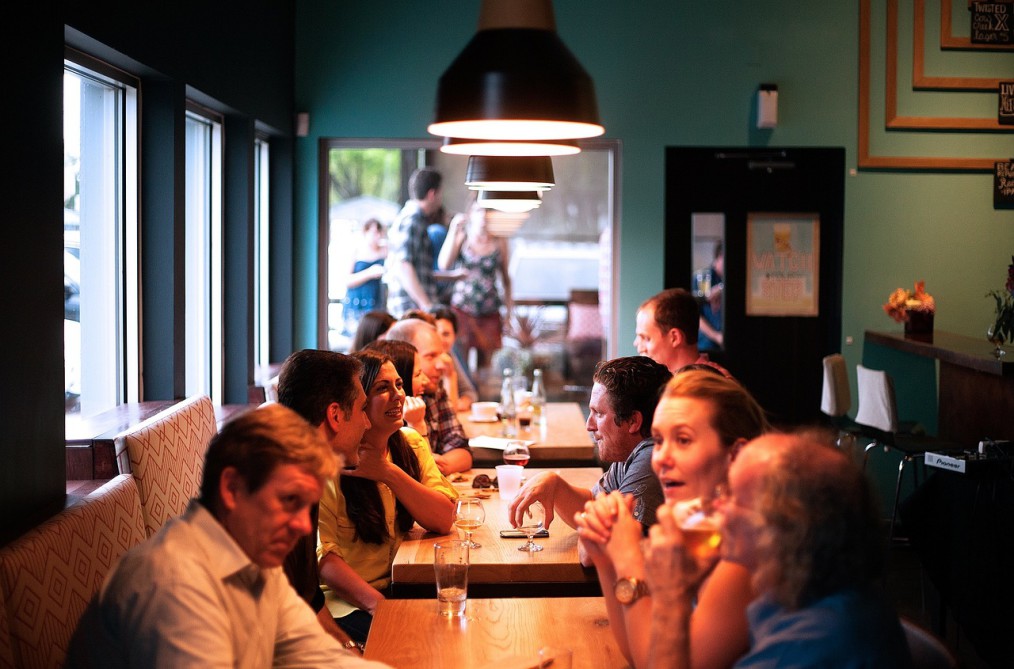
Countering negative stereotypes with positive stereotypes
How we see ourselves and others depends largely on everyday conversations and informal chats. People especially like to talk about other people and groups. For instance, native-Dutch students may gossip about their non-native Dutch teacher with that funny accent. These conversations are often primarily intended to amuse (Condor, 2006), yet may considerably change – or instead strengthen – the image that we have of a person or social group. Hence, innocent as such intragroup communication may seem, it may also have major consequences. That is, communication within groups can play a key role in escalation as well as de-escalation of conflicts between social groups.
In this process, perceptions of others are influenced not only by what people discuss (positive or negative aspects) but also by how they discuss this – that is, whether they focus on a concrete individual (“Jan is down-to-earth”) or more abstractly at an entire social group (“People from Groningen are down-to-earth”). There are several ways in which communication within one’s own group (for instance, among native Dutch people) can influence perceptions about other groups (for instance, Moroccan-Dutch people) and hence, contribute to the escalation or de-escalation of intergroup conflict. Below, I will illustrate how this works, and how within-group communication can be used to positively alter negative stereotypes that underlie intergroup conflict.
What do we talk about?
In the domain of intergroup conflict, ample research focuses on the beneficial effects of positive intergroup contact (Pettigrew & Tropp, 2006). However, whether contact leads to conflict de-escalation or escalation is influenced by group members’ expectations and motivations for intergroup contact (Saguy & Kteily, 2014). For instance, group members may expect downright rejection from the other group, or a cooperative approach to solve the conflict together. But what happens when we discuss these expectations with other members of our own group?
“When preparing to talk to people from conflicting groups people toughen up to defend themselves against anticipated hostility”
Ironically, our research on Groningen students and non-student inhabitants (or stadjers) shows that collective anticipation of face-to-face intergroup contact can have detrimental consequences for intergroup perceptions (Greijdanus, Postmes, Gordijn, & Van Zomeren, 2015). That is, students who prepare together for an encounter (organised by the researchers) with stadjers toughen up to defend themselves against anticipated hostility, by talking about incidents in which stadjers displayed hostile reactions towards students. Students who did not expect an interaction, talked less about such events. This suggests that anticipating intergroup contact affects what group members talk about, which in turn shapes individuals’ perceptions.
How does talking influence thinking?
Although we know that what we talk about with our fellow group members may influence what we think, the anticipation of such communication may be sufficient to alter perceptions (Zajonc, 1960). Anticipated communication may influence, for instance, whether people think more concretely or more abstractly. That is, we can think of people and situations concretely by recalling the details of how Jane hit Jack with her red purse on his head last Tuesday evening or abstractly by seeing Jane as an aggressive person. People tend to process and discuss information that is consistent with stereotypes abstractly. For instance, a Dutch stereotype about Moroccan-Dutch adolescents is that they are seen as anti-social or as criminals (Dotsch, Wigboldus, & Van Knippenberg, 2011; Greijdanus, Postmes, Gordijn, & Van Zomeren, 2014, pilot study; Van Prooijen & Coffeng, 2013).
“We interpret behaviour that contradicts our stereotypes as incidental, but behaviour that confirms stereotypes as typical”
Native Dutch who observe Abdul taking someone’s purse are likely to interpret this behaviour as evidence confirming the stereotype. However, native Dutch who observe Abdul helping his neighbour picking up the oranges she dropped (that is, stereotype-inconsistent information) tend to interpret this behaviour as an exception – for instance, they may say that Abdul did this here and now just because he is the only person around, but this is not representative for other situations or persons (Maass, 1999; Wigboldus, Semin, & Spears, 2006). Because of this tendency to process such stereotype-inconsistent information concretely as unique exceptions, stereotypes are often resistant to change.
Interestingly, in our research we show that mere preparation for intragroup communication about stereotype-inconsistent information, which is usually processed concretely, can facilitate abstract thinking (Greijdanus et al., 2014). This finding is of theoretical as well as practical interest, because stereotype-inconsistent information will more likely influence existing views if it is interpreted in a generalizing manner – which is not typically done. Thus, preparing to talk with your fellow group members about stereotype-inconsistent behaviour by members of another group may result in stereotype change.
Communication in practice: Improving intergroup perceptions.
These findings raise the question of whether and how communication content and abstraction level can be manipulated in intragroup conversations to reduce intergroup conflict. In other words, can we apply this scientific knowledge in designing an intervention in which fellow group members talk to each other to improve intergroup perceptions? To test this, we designed and tested intergroup conflict interventions in several experiments targeting different intergroup conflicts (Greijdanus, Postmes, Gordijn, & Van Zomeren, in preparation). The results showed that group members should be encouraged to collectively discuss abstract characteristics of other groups (rather than concrete individuals) that disprove negative intergroup perceptions.
Conclusion.
Taken together, the results of this research imply that a concrete positive conversation about a Moroccan-Dutch person such as Ali B has little effect on the perception of Moroccan-Dutch people as a group. However, a more abstract positive conversation about how hospitable and caring Moroccan-Dutch people are as a group improves native Dutch’s perceptions of them.
“Natural conversation tendencies facilitate maintenance of stereotypes”
The negative consequences of social categorization can thus be countered best by mentioning the category’s positive characteristics. However, if people have a negative perception about a group, they by default tend to do exactly the opposite: Information that matches a stereotypic image is discussed at a group level, whereas information that does not match this stereotype is discussed in a more individualizing manner. This implies that natural conversation tendencies facilitate maintenance of stereotypes. The conclusion of my dissertation is that negative stereotypes should be countered with positive stereotypes. So, if one intends to prove a negative stereotype wrong, one should suppress the tendency to list positive individuals and instead talk about positive, stereotype-disconfirming group characteristics.
Hedy Greijdanus will defend her dissertation entitled “Intragroup communication in intergroup conflict: Influences on social perception and cognition” tomorrow (June 25) at 14.30 in the Academy building.
References
Condor, S. (2006). Public prejudice as collaborative accomplishment: Towards a dialogic social psychology of racism. Journal of Community and Applied Social Psychology, 16(1), 1-18. doi:10.1002/casp.845
Dotsch, R., Wigboldus, D. H. J., & Van Knippenberg, A. (2011). Biased allocation of faces to social categories. Journal of Personality and Social Psychology, 100(6), 999-1014. doi:10.1037/a0023026
Greijdanus H., Postmes T., Gordijn E.H., & Van Zomeren M. (2015). Steeling ourselves: Intragroup communication while anticipating intergroup contact evokes defensive intergroup perceptions. PLoS ONE 10(6), e0131049. doi:10.1371/journal.pone.013
Greijdanus, H., Postmes, T., Gordijn, E. H., & Van Zomeren, M. (2014). When abstraction does not increase stereotyping: Preparing for intragroup communication enables abstract construal of stereotype-inconsistent information. Social Cognition, 32(6), 505-527. doi:10.1521/soco.2014.32.6.505
Greijdanus, H., Postmes, T., Gordijn, E. H., & Van Zomeren, M. (in preparation). Improving intergroup relations: Abstract and concrete intragroup communication about stereotypes.
Maass, A. (1999). Linguistic intergroup bias: Stereotype perpetuation through language. Advances in Experimental Social Psychology, 31, 79-121. doi:10.1016/S0065-2601(08)60272-5
Pettigrew, T. F., & Tropp, L. R. (2006). A meta-analytic test of intergroup contact theory. Journal of Personality and Social Psychology, 90(5), 751-783. doi:10.1037/0022-3514.90.5.751
Saguy, T., & Kteily, N. (2014). Power, negotiations, and the anticipation of intergroup encounters. European Review of Social Psychology, 25(1), 107-141. doi:10.1080/10463283.2014.957579
Van Prooijen, J.-W., & Coffeng, J. (2013). What is fair punishment for alex or ahmed? perspective taking increases racial bias in retributive justice judgments. Social Justice Research, 26(4), 383-399. doi:10.1007/s11211-013-0190-2
Wigboldus, D. H. J., Semin, G. R., & Spears, R. (2006). Communicating expectancies about others. European Journal of Social Psychology, 36(6), 815-824. doi:10.1002/ejsp.323
Zajonc, R. B. (1960). The process of cognitive tuning in communication. Journal of Abnormal and Social Psychology, 61(2), 159-167. doi:10.1037/h0047987




Great job!
Sure, let’s tackle everything but the fact that all stereotypes are true on average (More than half of Moroccan-dutch have been investigated by police for a crime). Everything in psychology is based on averages. So you either accept that stereotypes are true, or that psychology as a whole is a stereotype.